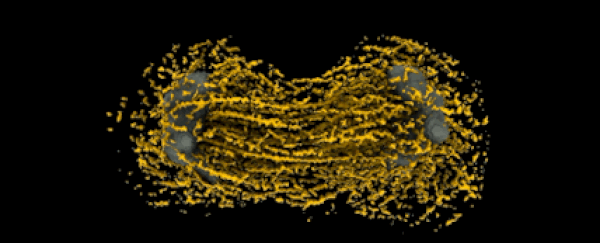Cell division is at the root of all life, and now, anyone who is interested can watch it unfold in all its microscopic complexity.
Researchers at the Allen Institute have created for the first time a highly-detailed visualisation of a dividing stem cell, and it is already revealing new secrets about the process.
Called the Integrated Mitotic Stem Cell, the updated tool allows users to see and rotate a detailed, data-driven model of human stem cell division.
While there are other beautiful depictions of cell division like this one, before now, there was no objective way for scientists to visualise all the major different parts of the cell working together during mitosis.
Even though there are roughly two trillion cell divisions going on in your body each and every day, the process itself is extremely complex. During mitosis, each cell must not only replicate its chromosomes, it must sequester its DNA and other contents, ultimately splitting into two identical daughter cells.
If that sounds too easy, imagine doing all of this under immense time pressure and strict quality control.
"Biologists have been looking at different images of cells and envisioning the relationships between them for decades, but to make precise comparisons, we can't just hope that everyone's mental model of a cell is the same," says team member Graham Johnson at the Allen Institute for Cell Science.
"These visualizations allow us to directly look at many different structures at once by superimposing them in the same space. Now scientists can make and discuss more concrete, more accurate comparisons."
By transforming microscopic images of 15 individual organelles and overlaying 75 representative cell images, the team has created an integrated view of the undifferentiated human induced pluripotent stem cell (hIPSC) at each major stage of mitosis.
Decorated by fluorescent tagging, the microtubules, cell membranes, mitochondria, Golgi, actin and nucleoli stand out vividly as they dance through interphase, prophase, prometaphase, metaphase and anaphase.
"Once you see this process as a complete picture, you can start to uncover new, unexpected relationships and ask and answer completely new questions about cell division," says Rick Horwitz, the head of the Allen Institute for Cell Science.
"It will also serve as a much-needed baseline of how normal human cells divide for comparison with cancer cells."
The team's hope for new observations on cell division has already been realised. Using the tool, they have found a "trigger point" in the early prometaphase stage, where many of the 15 cellular structures begin to change dramatically.
They have also noticed that during metaphase, right before the chromosomes begin to separate, the cell is organised with the least variation, in a highly stereotyped manner.
"We're interested in understanding the cell as a whole," team member and development cell biologist Susanne Rafelski told NPR.
"So the really big picture view is that we want to put the cell back together with all the mechanistic information that we've been gathering over the years now."
You can learn more about the whole fascinating process, the team's observations so far and explore the dividing cell in 3D yourself at imsc.allencell.org
Enjoy!

